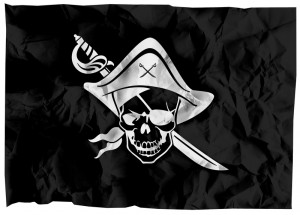Pirates. A far cry from Urban Fantasy, but, oh yes, pirates. Errol Flynn had me at arrrrgh with his first swing on the rat line in Captain Blood. Or maybe Tyrone Powers in The Black Swan. Maybe it’s the black boots, the swagger, or the devil may care attitude, but pirate heroes are my ultimate bad boys. (And I did love Depp as Jack Sparrow in the first Pirates, but that series lost it’s footing. I actually looved Geoffrey Rush as Barbossa)
And I mean pirate heroes. Not a privateer or falsely accused sailor. Like vampires who actually drink blood, I like my pirates to plunder from the East India Company and give to the disenfranchised. Okay, I know they probably had bad teeth and smelled like bilge, but this is romance, dammit.
I read a very excellent book, The Republic of Pirates, by Colin Woodard (tv show based on the book coming soon, SQUEEEEE). Woodard focused on three of the more successful Caribbean pirates: Charles Vane, Edward Teech a.k.a. Blackbeard, and Black Sam Bellamy, and the British patriot, Woodes Rogers, who eventually played a huge role in ending the Golden Age of Piracy (1715 – 1725). A great book worthy of a read. It inspired me to finally write a pirate historical romance, Devil’s Island, and inspired my hero, Captain Boone Wilder. Continue reading

